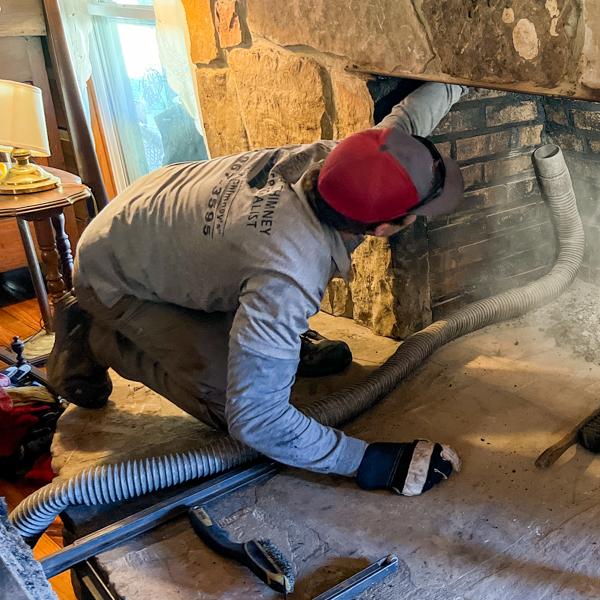Specialist Tips for Effective Chimney Upkeep You Need to Know
Smokeshafts offer as vital elements in many homes, offering warmth and convenience. From the relevance of routine assessments to risk-free functional techniques, a thorough technique to smokeshaft upkeep is crucial.
Relevance of Routine Evaluations
Routine inspections of smokeshafts are vital for ensuring their safety and capability. Chimneys play an essential role in airing vent out dangerous gases and preserving correct air flow in a home. Over time, creosote build-up, debris, and architectural damage can take place within the chimney, presenting serious dangers such as smokeshaft fires or carbon monoxide gas leaks.
Throughout a smokeshaft examination, educated professionals examine the condition of the chimney, trying to find any type of indicators of damage, obstructions, or wear and tear. They also inspect the integrity of the flue, chimney lining, and chimney cap to ensure whatever remains in proper functioning order. By determining and attending to concerns at an early stage, pricey repair services or possible hazards can be stayed clear of.
Normal inspections not just help in maintaining the security of the chimney yet likewise add to its total performance. A well-maintained and clean chimney operates a lot more efficiently, making sure appropriate air flow and reducing the risk of indoor air pollution. Therefore, organizing yearly smokeshaft inspections is a proactive step that homeowners can take to protect their building and enjoyed ones.
Cleaning Methods and Regularity
Preserving the safety and efficiency of a smokeshaft entails not just routine assessments yet likewise carrying out proper cleaning strategies and establishing the optimum frequency for cleansing. Smokeshafts should be cleaned up by a professional chimney sweeper a minimum of annually, even if they are not often used. Nevertheless, if the chimney is utilized routinely, especially with wood-burning ranges or fireplaces, it might require even more constant cleanings to prevent the build-up of creosote, a highly flammable material that can cause chimney fires.
The cleansing process normally includes getting rid of creosote, soot, and debris from the chimney flue, smoke chamber, and firebox. Expert smokeshaft sweeps use specialized devices, brushes, and vacuum cleaners to ensure complete cleaning without creating a mess in the home. In addition, they evaluate the chimney's structure for any kind of indications of damages or put on that may require repair services. House owners need to never overlook smokeshaft cleaning, as it is crucial for maintaining a safe and functional smokeshaft system - Chimney Maintenance San Jose. Normal cleansings not only minimize the danger of smokeshaft fires yet likewise boost the smokeshaft's total efficiency and longevity.
Dealing With Smokeshaft Leaks

When resolving chimney leaks, pop over to this web-site comprehensive evaluation and timely fixings are crucial to avoid water damage and maintain the structural stability of the chimney. Leaks in a chimney can lead to serious problems such as mold and mildew development, wear and tear of the chimney structure, and also possible fire threats. To properly resolve smokeshaft leakages, beginning by evaluating the this article chimney cap, crown, blinking, and stonework for any kind of indicators of damage or wear.
Understanding Creosote Build-Up
To understand the possible dangers of creosote build-up in smokeshafts, it is vital to recognize its development procedure and influence on chimney efficiency. Creosote is a black or brownish tar-like substance that accumulates inside chimney systems when timber or fossil gas are shed. As smoke climbs with the smokeshaft, it cools down and condenses, resulting in the formation of creosote, which follows the chimney walls.

Regular smokeshaft inspections and cleansings by a professional chimney sweeper are vital in avoiding creosote build-up and ensuring the safe procedure of your chimney system.
Safe Procedure Practices
Implementing correct safety procedures is essential for the protected and efficient procedure of chimney systems. Always make certain that the chimney is properly inspected and cleaned up regularly to eliminate any creosote build-up, which can lead to chimney fires.
Moreover, make certain to just melt seasoned wood in your fire place, as environment-friendly or wet wood can create even more creosote and create dangerous chimney obstructions. Last but here not least, never ever leave a fire unattended and always make certain the fire is totally snuffed out prior to going to sleep or leaving your home. By following these safe operation practices, you can delight in a cozy and comfortable fire while making sure the security of your home and loved ones.
Verdict
Finally, preserving your chimney is important for ensuring its safety and security and effectiveness. Regular inspections, correct cleansing methods, attending to leaks, taking care of creosote build-up, and complying with safe procedure methods are key facets of smokeshaft maintenance. By remaining on top of these jobs, you can avoid potential risks and extend the lifespan of your smokeshaft. It is essential to focus on chimney upkeep to maintain your home safe and cozy during the cooler months.
Over time, creosote accumulation, particles, and structural damages can occur within the chimney, posturing major threats such as chimney fires or carbon monoxide leakages.
If the smokeshaft is used regularly, particularly with wood-burning cooktops or fireplaces, it may call for more constant cleanings to avoid the build-up of creosote, a highly combustible compound that can lead to smokeshaft fires. (Chimney Maintenance San Jose)
To recognize the potential risks of creosote build-up in smokeshafts, it is important to identify its development procedure and influence on chimney performance. As smoke increases via the smokeshaft, it condenses and cools down, leading to the formation of creosote, which adheres to the chimney walls.
Constantly guarantee that the smokeshaft is professionally examined and cleaned up consistently to remove any kind of creosote accumulation, which can lead to chimney fires.